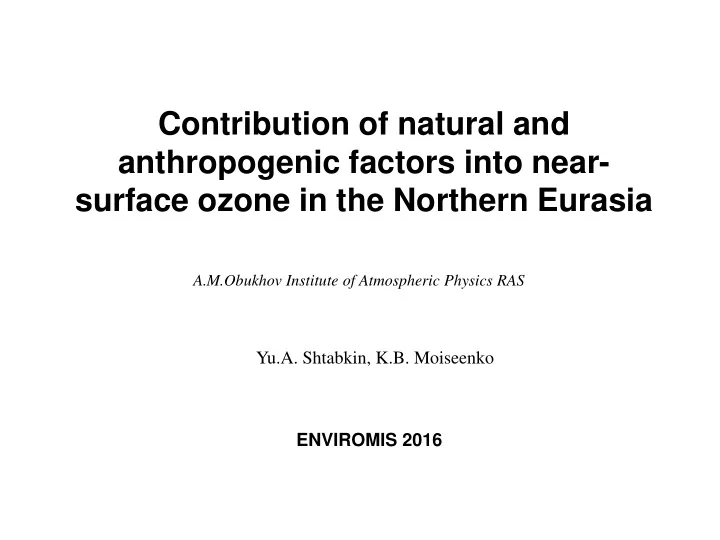

Contribution of natural and anthropogenic factors into near- surface ozone in the Northern Eurasia A.M.Obukhov Institute of Atmospheric Physics RAS Yu.A. Shtabkin, K.B. Moiseenko ENVIROMIS 2016
GEOS-Chem near-surface CO field Regions of climatically significant anthropogenic emissions
ZOTTO measurements: CO2, CH4, CO, Ozone, NOx and aerosols at different heights, meteorology at different heights and on the ground (Temperature, Wind, Humidity), biweekly flask sampling at 301 m height and various irregular ecosystem measurements Background character of the station provide an excellent opportunity to study regional as well as long- range impact of various climatically important sources of pollutants including regional industry and wildfires. zottoproject.org
Methods 1) Emission inventories: Anthropogenic (EDGAR, http://edgar.jrc.ec.europa.eu) Biogenic (VOC oxidation, MEGAN, http://bai.acd.ucar.edu/MEGAN/) Wildfires (GFED, http://www.globalfiredata.org) 2) Global chemical-transport model GEOS-Chem (http://acmg.seas.harvard.edu/geos). Input data • NASA GEOS Applications meteorological • Chemical processes, fields transport, budgets • Other • Inverse analyses • Radiative forcing • Air quality Modules • Biogeochemistry • Emissions • … • Transport • Chemistry • Aerosols • Deposition • Sub -surface
ZOTTO vs GEOS-Chem R= 0.77 (0.53 – 0.89), δ =16.6 (11.0 – 22.6) CO concentration at a height of 300 m above the ground observed at ZOTTO in 2007-2011. P10,90 - percentile, □ - average. The solid and dashed lines - GEOS-Chem model calculation (monthly averaged concentrations at the third model level, ~ 320 m above the ground).
Model Experiment Geographical areas used for CO emission impact evaluation: NETR – north of ЕТР , SETR – south and midland of ЕТР , NS – north of Siberia, SWS – south of western Siberia, SES – south of eastern Siberia, NFE – north of Far East, SFE – south of Far East, EU — western Europe. АО R = χ( СО) 0 – χ( СО) REG Summary diagrams of atmospheric response on CO emissions in different regions in warm and cold periods
GEOS-Chem vs ZOTTO R= 0.79 (0.67 – 0.87), δ =-3.5 (-4.8 – -2.2) Ozone concentration at a height of 6 m above the ground observed at ZOTTO in 2007-2012. P10,90 - percentile, □ - average. The solid and dashed lines - GEOS-Chem model calculation (monthly averaged concentrations at the first model level, ~ 58 m above the ground).
ZOTTO near-sutrface ozone sensivity to NOx and VOC emissions (I) Geographical areas selected for ozone reduction calculations АО R = χ(O 3 ) 0 – χ(O 3 ) REG Atmospheric response:
ZOTTO near-sutrface ozone sensivity to NOx and VOC emissions (II) Summer: NO x O3 Winter: NO x O3 Summary diagram of ozone reduction near ZOTTO station at different biogenic VOCs and anthropogenic NOx emission reduced values in Siberia, European Russia and Europe. An averaged values for all 2007 seasons are given.
ZOTTO near-surface ozone sensivity to NO x and VOC emissions АО REG = χ(O 3 ) 0 – χ(O 3 ) REG Atmospheric responce on anthropogenic and biogenic emissions in near-surface ozone field for summer 2007. NOx and VOC emissions are reduced by 100 %
Recommend
More recommend